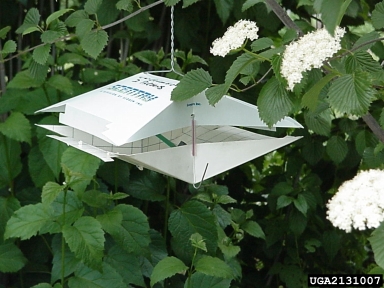Control Tactics
Viburnum clearwing borer control includes many
strategies to protect the shrubs typically preyed on by this
wood burrowing bug.
Typically, the borer attacks trees weakened by damage, dryness
and age (Cranshaw et al. 1999).
Therefore, simply maintaining the health of your tress
can greatly reduce the probability of a borer attack.
Avoidance of damage from weed whackers, lawn mowers and
poor pruning can be exercised when maintaining your landscape.
Other strategies include maintaining a watering schedule
to prevent the shrub, and its roots, from drying out.
According to
Cranshaw and Leatherman (1999), this is a
vital practice when the eggs of the borer are laid and they are
in season to hatch and tunnel into the roots of the plant.
Additionally, the use of landscaping mulch can deter and
make it more difficult for a borer to reach the root zone.
Chemical strategies are often exercised
during the adult moth egg laying life stage of the borer (Pellitteri
2004).
Unfortunately, larvae already underneath the bark of the plant
are shielded from any chemical treatment available.
In order to properly time the onset of adult activity,
Phil Pellitereri, from the University of Wisconsin – Extension
Insect Diagnostic Lab, suggests the use of pheromone traps to
monitor activity in spring. If you are unable to acquire
pheromone traps to assist in determining when to spray,
Pellitteri advises to spray initially mid June, and for heavy
infestations reapply the treatment mid July.
A recent research study conducted by Hartman and Parson
in 2005 attempted to record the flight patterns of the Virburnum
borer in northeast Wisconsin.
With the use of pheromone traps placed throughout Brown
county, observations found that the adult
Synanthedon viburni
fly beginning in late May and continue to be present
until early September in the Green Bay area (Hartman et al.
2005).
Pellitteri
also suggests that the pesticide used should contain insecticide
Permethrin and should be sprayed from the ground level to
approximately 18 inches up the shrub.
Hartman and Parsons also explored control options in
their research study by planting four different sections of Virburnum plants at the Agriculture and Extension Services
Center in Green Bay, Wisconsin (2005).
One of the four independent groups of plants were treated
bi-weekly with a spraying of Permethrin insecticide, two rows
were physically protected by tree wraps, and various tapes and
aluminum foil, and one row was left untreated.
After a period of treatment and observation, Hartman and
Parson concluded that applications of Permethrin during observed
flight periods of May-August at 14-day intervals was
statistically likely to keep shrubs free from borer invasion
(Hartman et al. 2005).
